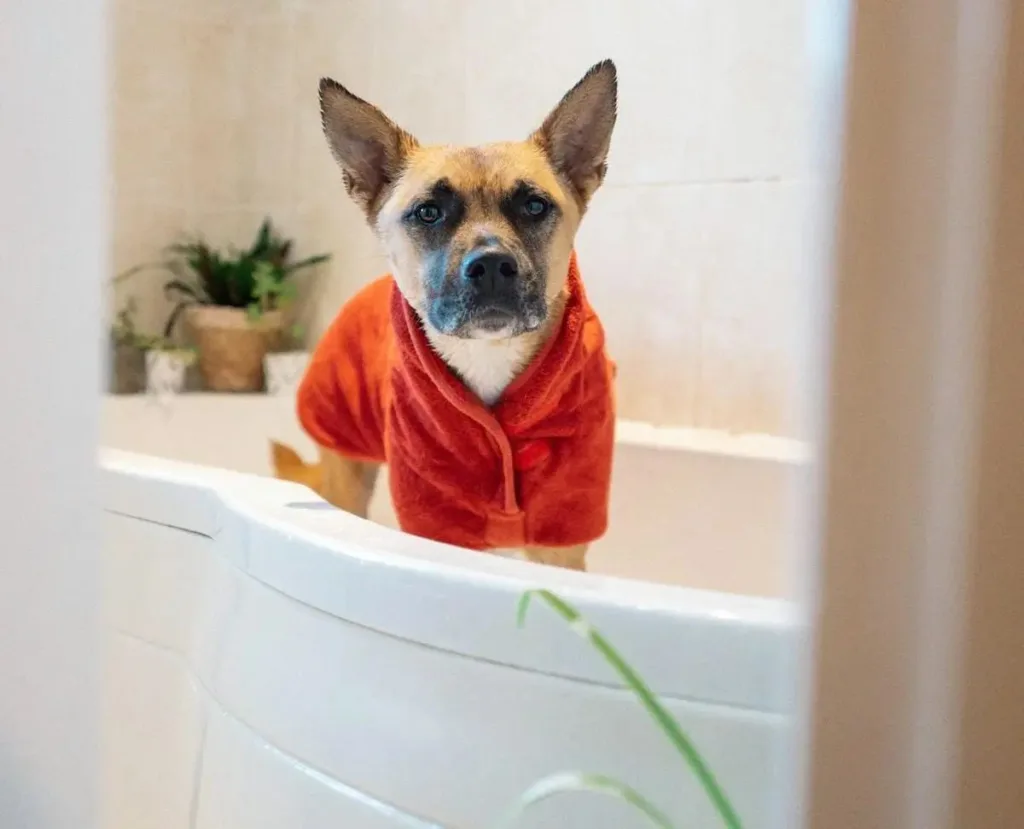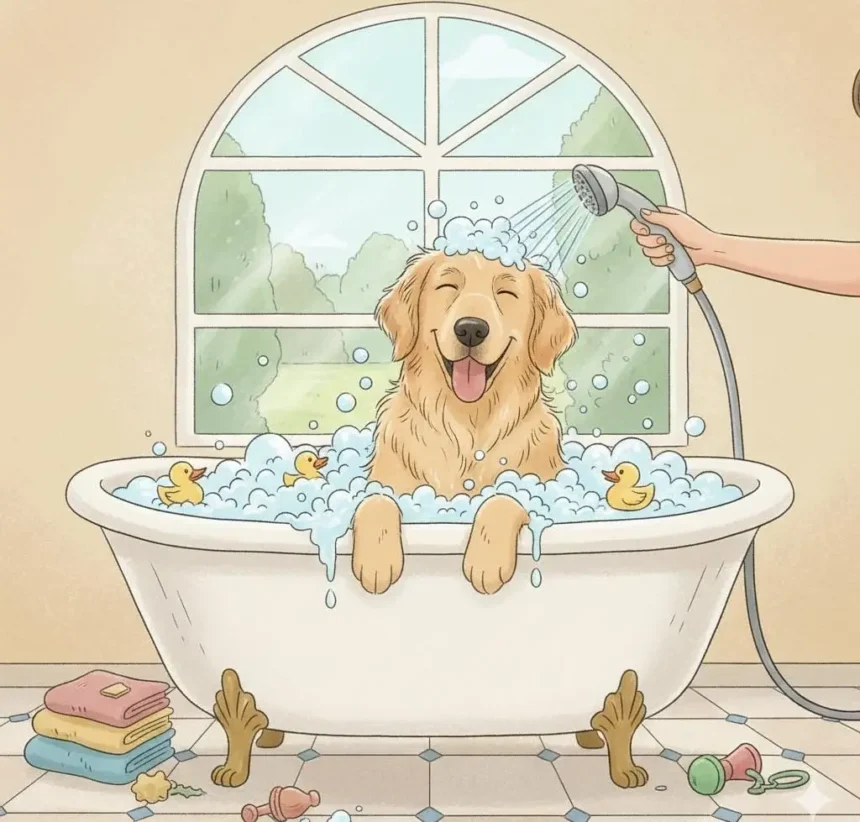Few things are as frustrating as your dog running into the house reeking of skunk spray. The odor is powerful, overwhelming, and almost impossible to ignore — clinging to fur, skin, and even your furniture. If you’ve been searching for the fastest and most effective way to get rid of skunk smell on your dog, you’re in the right place. This guide walks you step-by-step through proven home remedies, vet-approved treatments, common myths to avoid, and smart prevention tips so you and your pup can get back to smelling fresh in no time.
What Is Skunk Spray and Why Is It So Hard to Remove?
Skunk spray is a potent defense mechanism produced by anal glands containing sulfur-based chemicals called thiols and thioacetates. These oily, non-water-soluble compounds cause the smell to linger, and when exposed to moisture, thioacetates convert to smelly thiols, intensifying the odor. Skunks can spray up to 15 feet, often targeting the face, and the stench can persist for days or weeks if untreated.
Understanding this chemistry is key to effective “skunk smell removal from dog.” Without neutralizing thiols through oxidation, the odor can cause skin irritation or, in rare cases, health issues like anemia.
Immediate Actions: What to Do Right After Your Dog Gets Skunked

Swift action is critical for “de-skunk dog immediately” to prevent the oils from bonding deeply with fur and skin, which complicates removal. Delays can also spread the smell to your home or car. Here’s a detailed breakdown of immediate steps, incorporating expert recommendations.
1. Assess the Situation and Keep Your Dog Outside
Evaluate your dog for distress signs like excessive rubbing, squinting, drooling, vomiting, or lethargy. Skunk spray can cause temporary blindness, respiratory irritation, or rare cases of Heinz body anemia from heavy exposure, especially if ingested or repeated. Monitor for 24-72 hours; symptoms like pale gums, weakness, or dark urine require urgent vet attention, potentially needing blood tests, IV fluids, or transfusions.
Confine your dog outdoors in a secure area like a fenced yard, garage, or porch to prevent indoor odor transfer to carpets, furniture, or fabrics, where it can linger for weeks. If weather prevents outdoor bathing, prepare an indoor area by removing absorbent items like rugs or curtains.
Tip: In cold weather, provide a blanket or temporary shelter, but prioritize containment.
2. Check and Flush Eyes, Mouth, and Sensitive Areas
Skunks often aim for the face, so inspect eyes for redness, swelling, squinting, or discharge. Flush immediately with cool, running water for 5-10 minutes using a hose on low pressure or a clean cup. Avoid forceful streams to prevent injury. Use a dog-safe eyewash (e.g., Vetericyn or saline) for better results. If irritation persists, corneal damage occurs, or temporary blindness is evident, seek veterinary care immediately—eye drops or anti-inflammatories may be needed.
For the mouth or nose: If drooling, vomiting, or nausea occurs, rinse the mouth gently with water. Do not induce vomiting without vet advice. Respiratory issues like coughing may indicate inhalation; monitor and consult a vet if breathing difficulties arise.
Check for bites or scratches, as skunks can carry rabies (rare in spray incidents). Ensure your dog’s rabies vaccine is current; if bitten, contact a vet immediately.
3. Protect Yourself and Blot Excess Spray
Wear rubber gloves, old clothes, eye protection, and a mask to avoid direct contact, as oils transfer easily to skin and fabrics. Wash contaminated clothes separately with 1/2 cup baking soda added to detergent.
Use old towels or paper towels to gently blot (not rub) affected fur to remove excess oil before bathing. Rubbing spreads oils deeper. Focus on high-concentration areas like the face, neck, and chest.
4. Prepare for Bathing Outdoors
Set up an outdoor bathing station with lukewarm water, towels, and your de-skunking solution. Avoid indoor bathing unless necessary, as steam intensifies the odor. For puppies, seniors, or dogs with health issues, consult a vet to ensure the process isn’t too stressful. Contact your vet before using any solution if your dog has sensitive skin, open wounds, or if spray entered eyes/mouth.
These steps can mitigate up to 50% of the initial odor spread if done within the first hour, setting the stage for effective removal.
Proven Methods for Skunk Odor Removal: DIY vs. Commercial
For “proven ways to remove skunk smell from dog,” oxidation is essential to neutralize thiols, as the oils aren’t water-soluble. Below are veterinarian-approved methods, including detailed recipes, application tips, and alternatives, capable of eliminating 80-90% of the odor in one treatment, though severe cases may require repeats.
The Gold Standard DIY Recipe: Hydrogen Peroxide Mixture
This “best homemade skunk odor eliminator for dogs” oxidizes chemicals effectively and is vet-endorsed for affordability and efficacy, ideal for “de-skunk dog at home.”
Ingredients (for a medium dog; double for large breeds):
- 1 quart (32 oz) 3% hydrogen peroxide (avoid higher concentrations to prevent skin burns)
- 1/4 cup baking soda
- 1-2 teaspoons liquid dish soap (e.g., Dawn for grease-cutting; avoid harsh detergents)
Step-by-Step Application:
- Mix ingredients in an open container outdoors—it will fizz due to the chemical reaction releasing oxygen.
- Wet your dog’s fur slightly if dry, then apply the mixture from the neck down, massaging deeply into the coat for 5-10 minutes. Avoid eyes, ears, mouth, and genitals—use a diluted version (1:1 with water) on the face with a cloth.
- Let sit for 5 minutes (no longer than 10 to prevent bleaching, especially on dark fur, which may turn bronze).
- Rinse thoroughly with lukewarm water using a hose. If odor persists, repeat the process.
- Follow with a gentle dog shampoo to remove residue, then a conditioner for skin hydration. Rinse again and towel-dry in a warm, ventilated area. Air-dry fully to check for lingering smells.
Warnings: Mix fresh each time—storing can cause explosions from pressure buildup. Test on a small fur patch for allergies. Not ideal for dogs with open wounds or very sensitive skin; peroxide can irritate. If ingested, contact a vet, as hydrogen peroxide can cause vomiting.
Commercial Skunk Odor Removers: Reliable and User-Friendly Options
For “best skunk shampoo for dogs” without DIY hassle, enzyme-based or specialized products are effective and often safer for frequent use or colored coats.
Top Proven Products:
- Nature’s Miracle Skunk Odor Remover: Spray or shampoo; breaks down oils enzymatically. Apply, let sit 5-10 minutes, rinse. Safe for fabrics (~$10-15).
- Thornell Skunk-Off Shampoo: Peroxide-free, won’t bleach; lather, wait 5 minutes, rinse. Ideal for black dogs.
- Earthbath Deodorizing Shampoo: Natural with rosemary; use post-DIY for extra neutralization.
Application Tips: Follow label directions—wet fur, apply liberally, massage, wait, and rinse. Repeat if needed. Great for “skunk smell remover spray for dogs” in spot treatments.
Alternative Tips and Backups
- Vinegar Rinse: Mix 1 part white vinegar to 2-4 parts water. Apply after shampooing, let sit 5 minutes, rinse. Effective for mild cases but may leave a temporary vinegar scent.
- Avoid Myths: Tomato juice only masks odors temporarily and is messy—skip it. Regular soap alone fails as oils aren’t water-soluble.
- Repeat as Needed: For heavy sprays, multiple washes over days may be required. Use gentle products to prevent dry skin.
Common Myths and Mistakes to Avoid in Skunk Smell Removal
Myth: Tomato Juice Works: It only masks the odor temporarily; the smell returns when dry. Skip it—it’s messy and ineffective.
Myth: Regular Bathing Suffices: Soap alone doesn’t dissolve oils; always use an oxidizer.
Mistake: Wet Bath First: This activates more thiols, worsening the smell. Blot dry first.
Mistake: Indoor Bathing: Oils cling to everything—do it outside.
For Sensitive Dogs: Avoid peroxide if your pup has open wounds or very light fur; it can irritate or bleach.
Cleaning Skunk Smell from Your Home, Car, and Gear
Collar, Leash, and Bedding: Soak in the DIY mix or vinegar solution, then machine-wash with baking soda and detergent. Air-dry outside.
Clothes and Towels: Wash with 1/2 cup baking soda added; repeat if needed. For dry-clean-only, use a commercial spray. Air-dry in a ventilated area.
Car Interior: Wipe surfaces with Nature’s Miracle, then sprinkle baking soda overnight and vacuum.
Home Fabrics and Walls: Blot with diluted DIY solution, then enzymatic cleaner. For carpets, steam clean.
Yard: Hose down affected grass; the smell fades naturally.
For stubborn spots, professional ozone treatments or grooming services can help.
Prevention: Stop Skunk Encounters Before They Happen
The best “skunk odor removal for dogs” is avoidance. Skunks are crepuscular (active at dawn/dusk), so:
- Walk in well-lit areas, avoiding woods or brush. Use caution off-trails in wooded areas.
- Secure your yard: Remove food sources like garbage, pet food, or compost; block under decks and sheds.
- Use motion lights or ultrasonic repellents.
- Keep rabies shots current—skunks can carry rabies, though bites are rare during sprays.
- Train your dog with a strong recall to back away from wildlife.
When to See a Vet for Skunk Exposure
Most cases resolve at home, but watch for:
- Severe eye redness, squinting, or cloudiness; swelling, corneal damage, or temporary blindness.
- Vomiting, lethargy, or pale gums (signs of anemia from heavy exposure); chocolate-colored mucous membranes.
- Breathing difficulties or skin burns; nausea, drooling, or respiratory irritation.
Vets may prescribe eye drops, anti-inflammatories, or blood tests. For “dog sprayed by skunk in face,” err on caution—early intervention prevents complications. Seek care if heavy spray, multiple exposures, or ingestion occurred.
Frequently Asked Questions (FAQs)
1. How long does skunk smell last on a dog if untreated?
Untreated skunk spray can linger for weeks or months, especially in moist conditions, as thioacetates reactivate into thiols. Prompt treatment within hours can reduce this to days.
2. Can skunk spray harm my dog?
Yes, skunk spray can cause eye irritation, temporary blindness, skin inflammation, or nausea if ingested. Rarely, heavy exposure may lead to Heinz body anemia, signaled by lethargy or pale gums. Monitor and consult a vet if symptoms appear.
3. Is the hydrogen peroxide mixture safe for all dogs?
The DIY mix is generally safe but not for dogs with open wounds, very sensitive skin, or light fur prone to bleaching. Test on a small patch first, avoid eyes/mouth, and consult a vet for puppies or seniors.
4. Why doesn’t tomato juice work for skunk smell?
Tomato juice only masks the odor temporarily; it doesn’t neutralize thiols. The smell returns when fur dries, and it’s messy and ineffective compared to oxidizing solutions.
5. Can I use human shampoo to remove skunk smell?
No, human shampoo lacks the oxidizing or grease-cutting properties needed to break down skunk oils. Use a vet-approved de-skunking solution or dog-specific shampoo after the DIY mix.
6. What if the smell persists after treatment?
For stubborn odors, repeat the hydrogen peroxide mix or commercial product 1-2 times over a few days. If ineffective, consult a professional groomer or vet for advanced treatments like ozone therapy.
7. How do I prevent my dog from getting sprayed again?
Walk during daylight, avoid wooded areas, secure yard food sources, use motion lights or repellents, and train a strong recall command to avoid wildlife.
8. Can skunk spray make my dog sick long-term?
Most dogs recover fully with proper treatment, but untreated heavy exposure may lead to prolonged irritation or rare anemia. Regular monitoring and vet checkups ensure no lasting effects.
Final Thoughts: Reclaim Your Fresh-Smelling Furry Friend
Removing skunk smell from your dog doesn’t have to be a nightmare. With the right “de-skunk dog recipe” like the hydrogen peroxide mix or a reliable commercial product, you can banish the stench in hours. Act fast, stay safe, and prevent future run-ins for an odor-free life. Have you tried these tips? Share your success stories—what’s your go-to skunk smell remover?

